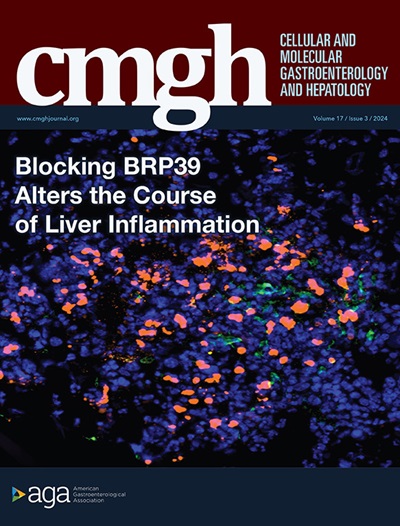二甲双胍激活AMPK可抑制pdgf - bb诱导的血管平滑肌细胞的去分化,从而改善肝硬化门静脉高压症的动脉重塑。
IF 7.1
1区 医学
Q1 GASTROENTEROLOGY & HEPATOLOGY
Cellular and Molecular Gastroenterology and Hepatology
Pub Date : 2025-01-01
DOI:10.1016/j.jcmgh.2025.101487
引用次数: 0
摘要
背景与目的:门脉高压(PHT)是肝硬化的潜在致命并发症。肝内血管阻力和内脏高动力循环是导致PHT维持和恶化的两个主要驱动因素。然而,在肝硬化晚期,肝脏的纤维化过程变得不可逆,导致肝内血管阻力持续和难治性增加。动脉重塑是驱动高动力内脏循环的重要机制。因此,改善高动力内脏循环已成为PHT治疗策略不可或缺的组成部分。方法:采用胆总管结扎法(BDL)诱导PHT大鼠肝硬化。基于肠系膜动脉转录组测序,我们研究了二甲双胍对肝硬化不同阶段动脉重塑的影响及其机制。我们通过A7r5平滑肌细胞系和原代血管平滑肌细胞(VSMCs)的体外实验进一步验证了潜在的分子机制。结果:我们的研究结果揭示了二甲双胍对胆管结扎(BDL)后4周和6周大鼠肝硬化和PHT的有益作用。观察到二甲双胍可以改善BDL大鼠的PHT和内脏高动力循环,即使在肝硬化晚期也是如此。门静脉压(PP)和心输出量(CO)降低,SMA流量减少,并伴有全身血管阻力(SVR)和SMA阻力的改善,证明了这种效果。二甲双胍可减轻BDL大鼠的慢性炎症,可能抑制血管生成和动脉重塑的驱动因子。值得注意的是,二甲双胍治疗后,BDL大鼠的SMA扩张和动脉重塑得到了有力的缓解。二甲双胍通过抑制可收缩VSMCs的去分化,导致α-SMA和SM22α等可收缩蛋白表达上调,改善BDL大鼠动脉重构。PDGF-BB/PDGFR-β信号在调节VSMCs细胞表型中发挥重要作用。二甲双胍激活AMPK阻断了PDGF-BB/PDGFRβ的下游通路。在体外细胞实验中,分别用AMPK激活剂二甲双胍或AMPK抑制剂化合物c处理VSMCs,揭示了二甲双胍抑制PDGF-BB诱导的A7r5细胞和BDL大鼠原代VSMCs表型转换的分子机制,其机制是通过激活AMPK,增强收缩蛋白α-SMA的表达。这些发现表明AMPK可以通过抑制PDGF-BB/PDGFRβ信号通路改善PHT期间动脉重塑的进展,从而为寻求PHT治疗方法提供新的见解。结论:我们的研究结果表明,二甲双胍通过激活AMPK通路,抑制内脏动脉收缩性VSMCs的去分化,改善动脉重塑,从而改善肝硬化大鼠PHT和内脏高动力循环。本文章由计算机程序翻译,如有差异,请以英文原文为准。

Activation of AMP-activated Protein Kinase by Metformin Inhibits Dedifferentiation of Platelet-derived Growth Factor-BB-induced Vascular Smooth Muscle Cells to Improve Arterial Remodeling in Cirrhotic Portal Hypertension
Background & Aims
Portal hypertension (PHT) is the potentially deadly complication of liver cirrhosis. Intrahepatic vascular resistance and the splanchnic hyperdynamic circulation are 2 principal driving factors contributing to the maintenance and exacerbation of PHT. However, in the advanced stages of cirrhosis, the fibrotic process in the liver becomes irreversible, leading to persistent and intractable increases in intrahepatic vascular resistance. Arterial remodeling emerges as a crucial mechanism driving the hyperdynamic splanchnic circulation. Therefore, ameliorating the hyperdynamic splanchnic circulation has become an indispensable component of PHT therapeutic strategies.
Methods
Liver cirrhosis with PHT was induced in the rats by common bile duct ligation (BDL). Based on the transcriptomic sequencing of the mesenteric arteries, we investigated the effects and mechanisms of metformin on the arterial remodeling at different stages of cirrhosis. We further validated potential molecular mechanisms through in vitro experiments using the A7r5 smooth muscle cell line and primary vascular smooth muscle cells (VSMCs).
Results
Our findings revealed the beneficial effects of metformin on liver cirrhosis and PHT in rats following BDL for 4 and 6 weeks. Metformin was observed to ameliorate PHT and splanchnic hyperdynamic circulation in BDL rats, even in the advanced stages of liver cirrhosis. This effect was evidenced by reduced portal pressure and cardiac output, decreased superior mesenteric artery (SMA) flow, accompanied by improvements in systemic vascular resistance and SMA resistance. Moreover, chronic inflammation in BDL rats was alleviated by metformin, which might inhibit the driving factors of angiogenesis and arterial remodeling. Notably, SMA dilation and arterial remodeling in BDL rats were potent alleviated following metformin treatment. Metformin ameliorated arterial remodeling in BDL rats by inhibiting the dedifferentiation of contractile VSMCs, resulting in the upregulation of contractile protein expressions such as alpha-smooth muscle actin (α-SMA) and smooth muscle 22α (SM22α). Platelet-derived growth factor-BB (PDGF-BB)/platelet-derived growth factor receptor beta (PDGFR-β) signaling exerted crucial roles in regulating the VSMCs cell phenotype. Activation of AMP-activated protein kinase (AMPK) by metformin blocked the downstream pathway of PDGF-BB/PDGFRβ. Furthermore, in vitro cell experiments, VSMCs were respectively treated with AMPK activator metformin or AMPK inhibitor Compound C. We revealed the molecular mechanism that metformin inhibited the phenotypic switching of A7r5 cells induced by PDGF-BB and primary VSMCs from BDL rats, which was mediated by activating AMPK to enhance the expression of contractile protein α-SMA. These findings suggest that AMPK can ameliorate the progression of arterial remodeling during PHT via suppressing the PDGF-BB/PDGFRβ signaling pathway, thereby offering novel insights into seek PHT treatment approaches.
Conclusions
Our findings revealed that metformin exerts its effects by activating the AMPK pathway, inhibiting the dedifferentiation of contractile VSMCs in the splanchnic arteries, and improving arterial remodeling, thereby ameliorating PHT and splanchnic hyperdynamic circulation in cirrhotic rats.
求助全文
通过发布文献求助,成功后即可免费获取论文全文。
去求助
来源期刊

Cellular and Molecular Gastroenterology and Hepatology
Medicine-Gastroenterology
CiteScore
13.00
自引率
2.80%
发文量
246
审稿时长
42 days
期刊介绍:
"Cell and Molecular Gastroenterology and Hepatology (CMGH)" is a journal dedicated to advancing the understanding of digestive biology through impactful research that spans the spectrum of normal gastrointestinal, hepatic, and pancreatic functions, as well as their pathologies. The journal's mission is to publish high-quality, hypothesis-driven studies that offer mechanistic novelty and are methodologically robust, covering a wide range of themes in gastroenterology, hepatology, and pancreatology.
CMGH reports on the latest scientific advances in cell biology, immunology, physiology, microbiology, genetics, and neurobiology related to gastrointestinal, hepatobiliary, and pancreatic health and disease. The research published in CMGH is designed to address significant questions in the field, utilizing a variety of experimental approaches, including in vitro models, patient-derived tissues or cells, and animal models. This multifaceted approach enables the journal to contribute to both fundamental discoveries and their translation into clinical applications, ultimately aiming to improve patient care and treatment outcomes in digestive health.
 求助内容:
求助内容: 应助结果提醒方式:
应助结果提醒方式:


